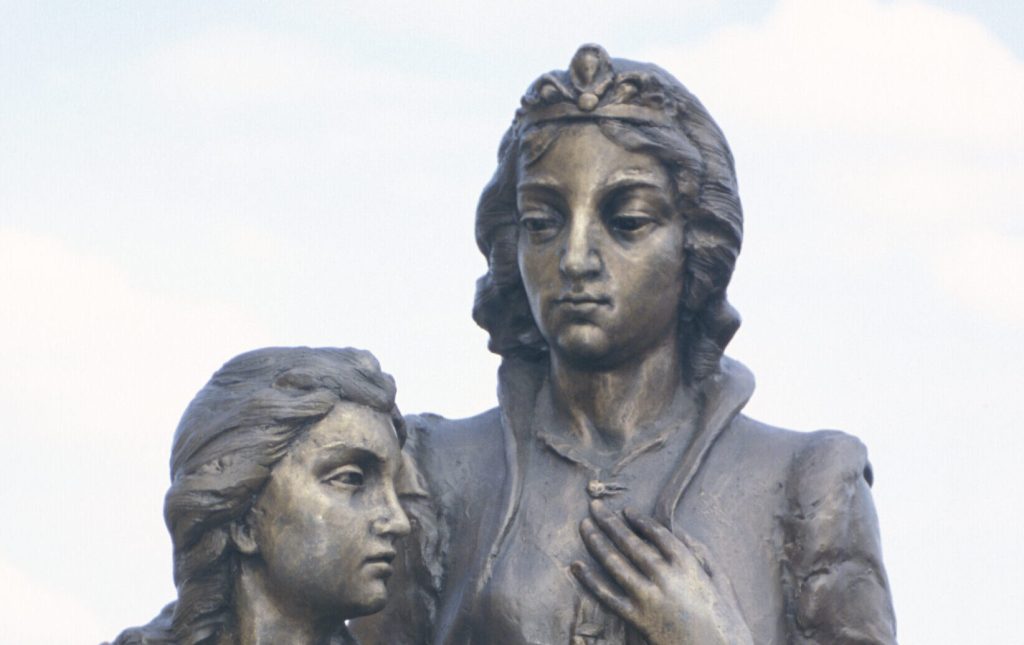On October 13, 2022, after a hasty decision from the city council of Mukachevo, Southwestern Ukraine, the visage of the once Hungarian-majority city changed forever. On that day, construction workers went to the city’s imposing 10th-century castle and barbarously sawed down the monumental statue of a bird that had adorned the castle’s battlements. The huge metal sculpture plummeted to the ground with a terrible crash and then shattered in the moat.
Mukachevo (or Munkacs in Hungarian) is a city of about 80,000 people in Transcarpathia, the westernmost county or oblast of Ukraine. In the city, which played an important role in Hungarian history, 73 percent of the population was Hungarian in 1910; by 2001, this had fallen to 8.5 percent. Historically part of the Kingdom of Hungary, the Transcarpathian region became part of Czechoslovakia after the First World War. It had been briefly reoccupied by Hungary in 1938, before the victorious Soviet Union claimed the geostrategically important region for itself after the Second World War. After 1989, the newly created Ukraine acquired the territory, with around 1,250,000 inhabitants, and with it some 151,000 Hungarians (12 percent).
But it was not only the Turul bird—a mythological symbol of the Hungarian people, most likely inherited from the once nomadic people’s pre-10th-century Asian roots—that fell into the dust last autumn. Hungarians, both inside Ukraine and outside of it, finally understood for good that Ukraine was not a Western-style liberal democracy dedicated to fundamental minority rights. The triple trident, the national symbol of Ukraine, which was erected in the place of the Turul a few days later, was a clear reminder of that.
This, of course, should not be news to those who read more than the overly optimistic Western press about Ukraine, or to those who have been following the legal situation of minorities in the Eastern European country in recent years. As the Russian stranglehold on Ukraine has tightened, the Ukrainian nation, once made up of fragmented groups, has turned to nationalism. Although understandable in the current circumstances, this development has put the nation’s minorities under increasing threat.
Although Ukraine is now on the fast track towards E.U. membership and is perpetually praised in Western media, this was not always the case. Surprising as it may seem today, a few years ago the main topic of discussion in various E.U. forums was not Ukraine’s “democracy project,” but the egregious violations of minority rights in Ukraine.
The list of grievances suffered by local Hungarians in the last couple of years is long. Hungarian cultural and political organizations are routinely targets of intimidation and harassment, including bombings and Ukrainian chauvinist groups menacing Hungarian marches. Members of representative organizations of the Hungarian community also face personal attacks. One example: In February 2018, the headquarters of KMKSZ (Transcarpathian Hungarian Cultural Association) was attacked with Molotov cocktails in Uzhhorod (Ungvar). There have also been mass anti-Hungarian text messages.
Sometimes, the pressure comes not from extremists, but from the Ukrainian state. In 2020, the offices of KMKSZ were raided by the Ukrainian secret service. The Hungarian activists were accused of “betraying the motherland” and “separatism.” The leader of the organization, Laszlo Brenzovics, is currently in exile in Budapest; he is under investigation by the Ukrainian authorities, but it will soon be three years without charge filed against him by the prosecutors. These actions are clearly a method of pressuring Hungarian cultural activists.
Of course, most websites and organizations protesting these incidents are linked to the Hungarian right—a source automatically deemed unreliable and pro-Putin by mainstream Western media. Yet, as a recent article from the Hungarian Socialist Nepszava daily—one of the oldest Hungarian newspapers in existence and fiercely opposed to the current Orban government—shows, the persecution of the Hungarian minority in Ukraine is reported on by bipartisan sources: The paper reported that Hungarian flags are being taken down from villages with a significant Hungarian population, with Ukrainian policemen overseeing the action.
This is of course nothing compared to what happened back in 2018, when a Ukrainian nationalist website started uploading the names and addresses of Transcarpathian locals with dual Hungarian citizenship to its public database. If, in contrast to Russia’s truly repressive policies, Ukraine is the E.U.-worthy home of democracy and liberalism, the local Hungarians have certainly not seen evidence of it.
Of course, the pro-Ukrainian side would probably argue that this is all justified. The treatment of minorities in Ukraine underwent a significant shift after the Russian annexation of Crimea and the loss of Donbas to separatists in 2014. With ethnic Russians comprising 17 percent of Ukraine’s population as of 2001 and twice as many individuals speaking Russian as their native language, Kiev adopted several frameworks aimed at promoting minority assimilation. The previous Law on Education, passed in 2017, and the Law on Language, passed in 2019, served as the primary instruments for this process. These laws effectively prohibited the use of languages other than Ukrainian in schools and the public sphere. The laws were meant to target Russians and Russian speakers, but they hurt Hungarian minority rights as well.
It would be unfair to say that E.U. bodies turned a blind eye to this issue—at least initially. In 2021, the European Parliament’s Intergroup for Traditional and Linguistic Minorities discussed the situation of the Hungarian minority in Ukraine, where MEPs were shocked to hear reports of new restrictions and atrocities against Hungarians in Transcarpathia. The European Parliament’s E.U.-Ukraine Parliamentary Association Committee (E.U.-U.A. PAC) plenary session of March 13–14, 2019, included a lengthy debate, in particular on the draft law on “Ensuring the Functioning of Ukrainian as a State Language.” The Venice Commission, an advisory body of the Council of Europe, even proposed amendments to the 2017 education law, so that it would be more tolerant of national minorities, but to no avail. Because of the haste surrounding the acceptance of Ukraine into the “elite circle” of Western democracies, many of the failings of the current regime remain overlooked.
One can also cite the new 2019 law on Ukrainian education and the reorganization of local administration between 2015 and 2020. The latter effort reorganized the districts or raions of Transcarpathia as well, reducing their number from thirteen to six, clearly to create Ukrainian-majority districts. In 2021, a law was passed on the protection of “indigenous minorities” of the Ukraine, which omitted Hungarians, despite their presence in Transcarpathia dating back over a thousand years.
This already difficult situation went from bad to worse with the Russian invasion of 2022. Following Putin’s assault, the dwindling numbers of Hungarians in Transcarpathia are facing a particularly difficult situation. On the one hand, they are suffering from a series of measures taken by the Ukrainian authorities, while on the other hand, Hungary’s balanced and sober policy towards the war is sparking tensions with the hardliners on the Ukrainian side.
Last December, a new law was passed that recognizes only individual minority rights, but not collective rights. Local Hungarian critics claim Hungarian-language education would no longer be guaranteed from kindergarten to the university level.
Today, the Hungarian government seems to stand alone in voicing concern for such mundane issues as national minority rights. Viktor Orban’s government has protested the destruction of the Turul statue and the removal of Hungarian flags—all in vain. Only two weeks ago Hungarian Foreign Minister Peter Szijjarto traveled to Strasbourg and indicated that the Hungarian government had requested international assistance for the violations suffered by the Hungarians in Transcarpathia.
This does not mean that the Hungarian government is opposed to Ukraine joining the E.U. The Hungarian position is that the rights of national minorities have to be respected. Only a few days ago, the European Commission launched a massive fund meant to help Ukrainian companies integrate into the E.U.’s Single Market. While Ukraine is only a candidate for E.U. membership now, the E.U. is already treating Ukraine’s accession as a fait accompli. Of course, by the time Ukraine is able to accede to the E.U., there will probably not even be a Hungarian minority in Transcarpathia to discuss.
Regarding the exodus of Hungarians from the region, it is difficult to find concrete numbers, even from Hungarian sources. Since the war began, almost one million refugees have traveled across the Hungarian-Ukrainian borders, not counting those who have traveled to Hungary through Romania. Many of these must have been Hungarians. Most of the refugees move on, but many are staying. From personal experience, it is difficult to step onto a playground in Budapest today and not hear Ukrainian.
There’s another good reason that many Hungarian families have left Ukraine. Several reports have claimed Ukrainian authorities are heavily drafting among minority regions. Again, proper data is missing—we don’t even know how many Ukrainian and Russian soldiers have fallen, let alone the percentage of Hungarians among forced draftees—but anecdotal articles indicate that the Ukrainians are trying to spare the big, Ukrainian-majority cities and are drafting minorities instead.
The process is hardly democratic. According to the New York Times,
Recruiters approach young men on the street, but the standards are not always clear and there are reports of unwilling men being signed up while some eager to fight are turned away…. A petition signed by more than 25,000 Ukrainians, the threshold for requiring President Volodymyr Zelensky to respond, requests a ban on issuing summonses at checkpoints, gas stations and other public places. It asks him to establish a transparent process for when people might be called up.
Of course, the NYT will not write down the obvious, namely, that unsuspecting men are dragged away from the streets to die in the war, but videos circulating in Hungarian media speak more than a thousand articles. Men are rounded up in markets; streets are blocked by Ukrainian military as bystanders are hauled away; masked men break into family homes and drag away fathers from the arms of their children. A Hungarian political scientist has posted one such disturbing video. More stills and photos are included in this report of the Hungarian state media.
With fake news and manipulated images common occurrences in this war, some of this evidence might not be true; however, I could not verify that any of them were fake. At the same time, of course, Russia is also reportedly using conscription—hardly a surprise in Putin’s Russia. But Russia is never hailed as a model democracy, while Ukraine, which is dragging men from their kids’ arms, is.
If there is one thing on which liberal and conservative Hungarian news sites agree, it is that this phenomenon is also affecting the Transcarpathian region. Units with a significant number of ethnic Hungarian soldiers are “often deployed in the bloodiest, toughest battles.… Soldiers returning from the front describe what they saw and experienced on the Eastern Front as hell on earth.… Morgues in Mukachevo, Transcarpathia are filled with soldiers killed in the war,” a liberal news portal adds. Similar reports appeared in the right-wing press.
Subscribe Today
Get weekly emails in your inbox
Again, it is unclear how many of the fallen are ethnic Hungarians or from mixed families. However, Orban stated in an interview in early March that ethnic Hungarian soldiers are dying on the front lines “by the hundreds.”
How many Hungarians remain in Transcarpathia today? We don’t know exactly, but an article from April last year in the Hungarian conservative daily Magyar Nemzet suggests the number back then was less than 100,000—meaning that in just under two months, one-third of the community left. While most refugees in Hungary are women and children, one can be sure that many Hungarian men of military age have fled as well. Those who remain are likely from the remote and poor villages near the Hungarian border.
Ukraine might yet survive this war, and if it does, the “international community” (meaning the U.S. and its allies) will certainly come to its aid with huge loans and grants. No one, aside from Hungary—a small country with a relatively small economy—seems ready to assist the Hungarian minority. Ukraine might yet survive, but its Hungarian minority most probably won’t: bled out, fled, intimated, and assimilated, their absence will serve as testimony that the liberal West watched an indigenous, thousand-year-old ethnic group was destroyed—and did nothing.









